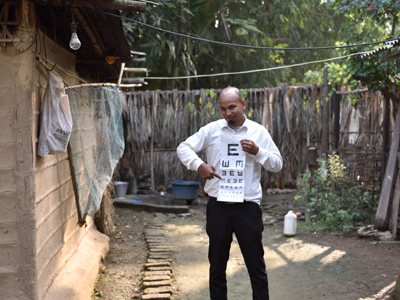Khairunissa: Gender Balance in Rural India
Created By: Elizabeth Kurian

Khairunissa, 68, has been working with Mission for Vision partner Tulsi Chanrai Eye Hospital as a social worker since the inception of the hospital in 1994 at Nashik. When she was selected to become a Social Worker, her own maternal uncle was suffering from blindness. Over the years how she has made an impact…
What are some of the challenges you have in your journey?
I have faced many challenges in my journey. Because of this community health work, I separated from my husband, who was opposed to it. I am a survivor of gender-based violence; my husband physically & mentally abused me. So, finally I decided to separate from him. It was a very tough decision but my family stood by me. When I look back I feel proud about my decision.
For a conservative Muslim woman like me it is quite difficult to step out from home and work with community in a rural area, where the bias about working women is high. I accepted that challenge, and through hard work & commitment have developed a rapport with the community. They have accepted me as a woman health worker.
What is the one thing that has helped you get to where you are today?
Support from my family. Especially my mother who stood behind me. Also, my colleagues & staff of Tulsi Eye Hospital, Nashik helped me a lot.

Why is it important to achieve gender balance?
Due to lack of access to health services & education women & girls suffer more in rural areas. Priority is always given to men over women when it comes to access. I think giving access to good education & quality health services to women in rural areas will help improve the situation. This can empower them in decision making process also.
As a woman, why are you committed to doing this work?
Because I have a passion to serve marginalised communities. I hope, seeing my work, more girls in rural areas will take up this profession. I feel happy when I see a smile on the face of woman when her sight is restored.
How have you helped change the gender balance?
In rural areas priority for health is given to men. Women come last, when it comes to getting access to improve their health status. I have visited homes in rural areas & motivated the women population to go for treatment for their eyes & other health related problems. As I have experience of ASHA workers, I also motivate rural women to become literate. I also work for the adult literacy programme.
How is your organisation working to achieve gender balance?
Our hospital always prioritises women and their eye health. We run awareness camps for gender sensitisation.

How can we support younger women in your profession?
You can support these women to take up this profession by providing quality education and, by providing equal opportunities for women.
How can the eye health sector work towards gender balance?
We can create awareness about eye health seeking behavior among women. We can organize special camps for women not only for eye health but other health problems also. Eye health can be introduced at PHC level so that a greater number of women can easily access these primary eye health services. We can make them economically independent by establishing self-help groups.
Khairunnisa’s story was put together by Dhanaji Ranpise, Manager–Programme Impact, Mission for Vision.
Originally posted in IAPB's blog: https://www.iapb.org/news/women-in-profile-for-international-womens-day-2019-khairunissa/
SHARE NOW:
RELATED ARTICLES

Eye Screening of Tea Tribes in Assam
Here is an article that explores the challenges in delivering eye care to Tea Tribes in Assam
Read More
The Uphill Eye Health Challenge
Traditionally, Mizoram’s hilly terrain poses many challenges in terms of accessing eye care services. Here are some challenges and solutions that could address this issue.
Read More
The Quest to Finding Our Eye Health Hero
I was rummaging through some information on International Agency for the Prevention of Blindness’ (IAPB) website and I stumbled upon a poster for the Eye Health Hero nomination.
Read More